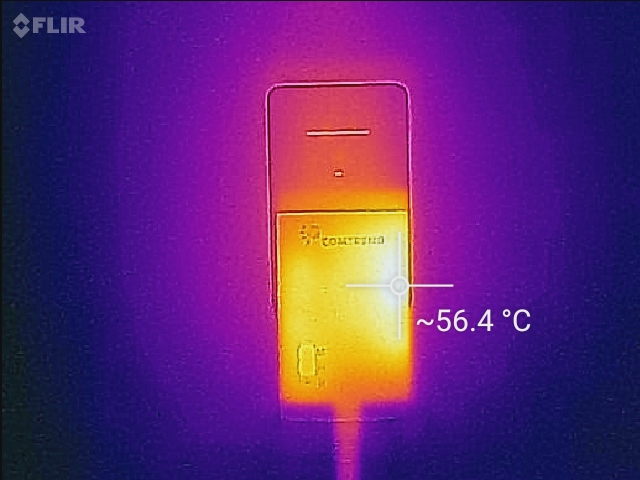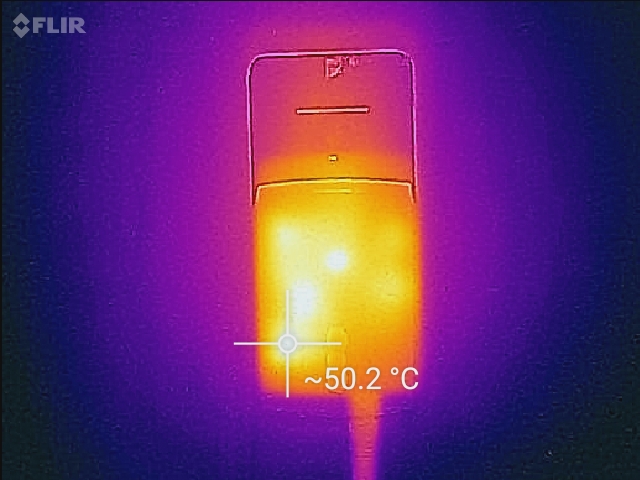Comtrend PG-9172 Powerline Adapter Review: G.hn Gets Primed for Retail Push
by Ganesh T S on May 3, 2016 8:30 AM EST- Posted in
- Powerline Adapters
- Networking
- Marvell
- G.hn
- HomePlug
- Comtrend
Miscellaneous Aspects - Power, Thermals and Coexistence
Powerline adapters tend to get quite warm under sustained loading conditions. The power consumption is also an interesting aspect, since these devices are kept on 24x7. We evaluated these aspects for the Comtrend PG-9172 and the ZyXEL PLA5405. While the master node was left as-is (with the DHCP server NUC connected) in the 'M' location in the floorplan, the other member of the adapter pair was connected to a Ubiquiti Networks mFi In-Wall outlet in the same room as Node C. The In-Wall outlet allows measurement of instantaneous power consumption.
A stress test was set up with iperf servers and clients running on the NUCs at either end. 16-stream TCP benchmarks were processed for 30 minutes from both sides simultaneously.
Under these sustained loading conditions, the G.hn pair was able to maintain 60 Mbps+ uplink and downlink, while the HPAV2 MIMO pair was able to maintain around 40 Mbps
At the end of the 30 minute stress test, thermal photographs of both units were taken using the FLIR One for Android thermal camera.
We find that the G.hn adapter ran hotter (more than 56C) compared to the HPAV2 adapter (around 50C)
The power consumption of the adapters was also recorded under different scenarios. Under stress, the HPAV2 adapter does consume more power than the G.hn adapter. However, the thermal design must be better in the former in order to maintain a lower case temperature. On the other hand, under idle conditions, the disabling of the power saving feature by default in the G.hn adapter results in much higher power consumption compared to the HPAV2 adapter.
| PLC Adapter Power Consumption | ||
| Scenario | Comtrend PG-9172 | ZyXEL PLA5405 |
| Normal (No Traffic) | 3.19 W | 1.98 W |
| Stress Test (TCP) | 3.85 W | 3.97 W |
Coexistence is important if G.hn adapters end up getting installed in apartments with pre-existing HomePlug networks. Marvell has been working on updating the firmware to improve coexistence. Even though our review units were not equipped with the latest coexistence firmware, we decided to test out whether HomePlug and G.hn networks could co-exist. Towards this, we created a HomePlug AV2 network to extend our primary network (192.168.1.0 subnet) and retained the G.hn network described above. The HPAV2 network's master node was connected to a power outlet in the wall adjacent to the G.hn master node.
Traffic in our primary HPAV2 network was restricted to a series of pings (over Wi-Fi to a PC connected to the second powerline adapter). In this scenario, we processed the stress test on the G.hn network. There is a clear loss of bandwidth, and the consistency exhibited in the previous run was no longer present. However, it did manage to stay above 35 Mbps all through. On the HPAV2 side, we lost around 4 packets out of a few thousand. On the whole, our conclusion regarding coexistence is that it works in our limited testing. Future firmware updates might help lessen the impact on the HPAV2 network while also enabling the G.hn network to have better performance consistency.















48 Comments
View All Comments
gobaers - Tuesday, May 3, 2016 - link
My current setup is two Ubiquiti Unifi access points, one connected directly into the firewall and the other connected via TP-Link HomePlug adapters, as well as an IP phone via HomePlug adapter as well. They're somewhat reliable, but I see one of the powerline adapters drop connectivity every few days. Really, I should wire the house with Cat6, but it's going to be a messy job.Replacing the consumer Netgear WNDR3400 with a Cisco ASA5505, and adding Unifi WAPs has been an awesome. Running the Unifi controller software on a desktop, live handoffs and great wifi through the house, it has been rock solid at least until the powerline adapter disconnects.
Acarney - Tuesday, May 3, 2016 - link
Any word on ping times with just a single brand/point to point network setup? I'm mainly looking to hardware my TV/AppleTV/PlayStation 4 with my network. I have an old G wifi hub connecting via bridge mode to my router which is about two rooms over. I need to hard connect these devices because if I don't they decide to connect to the wifi access point upstairs... Which is ok, except it randomly drops occasionally to where the one downstairs a couple rooms over is stronger. It's just a pain if gaming or streaming and a cut out happens. My internet pings are about 25 to 35ms at the best. Would a power line network drastically extend those? (Say into 100ms+) if it was just router -> power line plugin -> power line plugin -> network hub to break it out into 3 plugs for TV, AppleTV, PS4.paranoised - Thursday, May 5, 2016 - link
I have a Homeplug AV2 device and the latency I see is typically in the 2-4 milliseconds. Using powerline networking will probably increase your throughput and reduce latency tangibly.rtho782 - Tuesday, May 3, 2016 - link
I wish I could find testing like this in a UK setup.As our electrical wiring is significantly different (ring mains rather than radial circuits, leading to signal reflections etc, much more common use of RCBOs for individual rings, meaning that to go upstairs to downstairs, or either to the kitchen, you travel through two RCBOs) you can't directly compare the results, and UK/Europe seems to be an afterthought to the US!
Lepton87 - Wednesday, May 4, 2016 - link
I concur, I actually looked up what G.hn means once the author used it because he didn't explain what he meant by that. I don't like reading something and not be sure what I'm reading about so even though it would be clear after a while what G.hn means just from the article it still makes the first page more confusing that it should be. Please change it so the others don't have to look it up or not be sure at first what they are reading about.Lepton87 - Wednesday, May 4, 2016 - link
I concur, I actually looked up what G.hn means once the author used it because he didn't explain what he meant by that. I don't like reading something and not be sure what I'm reading about so even though it would be clear after a while what G.hn means just from the article it still makes the first page more confusing that it should be. Please change it so the others don't have to look it up or not be sure at first what they are reading about.jardows2 - Wednesday, May 4, 2016 - link
**Disclaimer: I work for ARRIS consumer support**We received samples of the G.hn products to test and learn for support purposes. We were unable to do any detailed tests, but were able to take some units home for pre-release trials. So far, everything seems to work well for everyone that tested, even those who had old wiring and fuse boxes! No word on speed, but connectivity seemed to be fine, except certain surge protectors were problematic. I am looking forward to AnandTech's full evaluation of the products!
sepecat - Wednesday, May 11, 2016 - link
The most problematic weakness of all RF-based tech (including powerline, MoCA, and wireless) for me is high latency. I've tried multiple iterations of each of these and always have a latency of at least 2ms and often over 10ms. This is a showstopper for my primary application, streaming from my PC to a SHIELD console. I don't see how that could be resolved without a dedicated, noise-free medium, though.